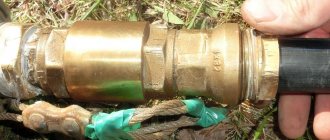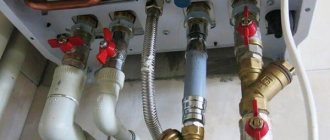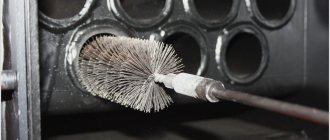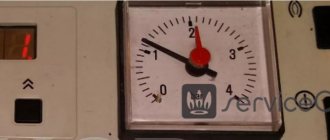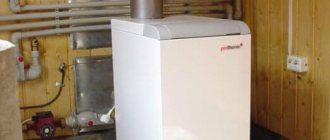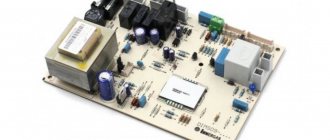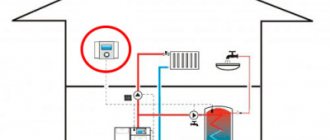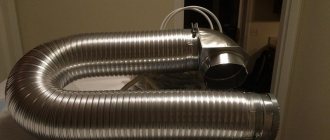Home / Gas boilers
Back
Published: 11/13/2019
Reading time: 5 min
0
3636
A gas valve is required to organize a fuel supply system to the gas burner device of the boiler. This allows it to operate in an economical mode with high power, guaranteeing safe operation and automatic control of thermal processes.
Photo source: ulyanovsk.santechsystemy.ru
This device is operated under increased load, since it constantly works in tandem with a source of thermal energy, so its parts and components are subject to wear and require periodic repair and maintenance. Simple gas boiler valve repairs can be done independently at home.
- 1 Types of valves in a gas boiler
- 2 Valve design 2.1 Operating principle
- 4.1 Checking electrical components
Possible malfunctions and DIY repair methods
The house smells like gas
Do you smell gas? This shows it is leaking. Open the window and turn off the equipment. According to the instructions, you will need a household solution of soap and water, FUM tape, and a suitable adjustable wrench. Next, the solution must be distributed to all threaded connections. If bubbles appear, there is a leak in these places. After this, we turn off the gas, use a wrench to unscrew the connection and wind the FUM tape onto the external thread.
Then you need to put everything back together, reapply the solution, and connect the gas. If we managed to eliminate the leak (there is no smell of gas), we remove what is left of the solution. However, if a leak is not found, you need to turn off the valve and invite a specialist.
Fan doesn't work
You can repair the system without calling a technician if the power of the boost fan is lower than required, or there is a loud noise while it is running. First, remove the fan and disassemble its housing. If possible, you need to remove the bearings, lubricate them or replace them. It could also be a winding issue. A transformer will help correct low network voltage. If you need to repair electronics, or if your actions have not brought results, you need to call a technician.
We recommend: Why does a gas boiler go out?
The chimney of a floor-standing boiler is clogged
To resolve the issue, you will need a metal brush. Disassemble the chimney and remove dirt yourself. If the chimney is solid, it can be cleaned with prepared chemicals or devices. For the last option, call a specialist.
High temperatures
When the heat exchanger is dirty, it causes overheating of the equipment.
Turn off the boiler, gas, turn off the water. Next, remove the heat exchanger with an adjustable wrench and clean it with a brush. The hydrochloric acid solution is then poured through the pipe into the heat exchanger. Foam indicates accumulated scale. Pour the solution, repeat until the desired result. Next, after washing, you need to install the heat exchanger back, winding all threaded connections.
Self-shutdown
When it turns off, the gas boiler does not work; this may be caused by a defect in the combustion sensor or the need to clean the chimney. To solve the problem, we remove the obstacle that has arisen to the further functioning of the system.
Cleaning the boiler heat exchanger
Typically, heat exchangers are made of stainless steel (then we clean it with a wire brush) or copper (a metal sponge will do here). You need to turn off the equipment and wait until it cools down. Turn off the faucet and remove the face cap, then discard any remaining water. Next, remove the heat exchanger and clean it mechanically, then leave the heat exchanger in a solution of citric acid or vinegar (1 tablespoon per 1 liter of water), or in the prepared mixture for a couple of hours, until completely cleaned. Next, rinse and dry. Return to original position.
Electrical failures
You should have special stabilizers at home to prevent breakdowns due to power surges, especially if you have a wall-mounted unit.
We recommend: Do you need a stabilizer for a gas boiler?
Incorrect installation
In case of installation errors, it is recommended to immediately invite a specialist, since incorrect installation threatens to break all equipment.
How does a gas valve work?
Most gas units have a SIT valve. It includes the following elements:
- gas pressure measuring port at the valve outlet;
- adjusting screw for minimum and adjusting nut for maximum fuel consumption;
- lid;
- inlet pressure measuring port.
The gas boiler valve consists of a shut-off and modulation coil. When a voltage of 220 V is applied to the shut-off valve, a minimum volume of gas is supplied to the burner in accordance with the factory settings. The voltage is then transferred to the modulation coil. The processor, depending on the operating mode (power), supplies voltage with different modulation frequencies, regulating the amount of gas passing per unit time.
To set the boiler gas valve to minimum power, you will need a differential pressure gauge, a wrench and a screwdriver. The setup process includes the following steps:
- Remove the protective cap covering the differential valve screws.
- Open the fitting to measure the gas pressure supplied to the burner - turn the locking screw 1.5-2 turns counterclockwise.
- Connect the pressure gauge hose to the inlet fitting.
- Turn on the heating mode and disconnect one wire of the modulation coil - this is necessary so that the valve supplies gas to the burner to a minimum, which will correspond to the minimum power of the unit.
- According to the pressure gauge readings, set the minimum gas pressure on the burner. To do this, rotate the internal screw located under the protective cap. At the same time, fix the outer nut.
How to repair boiler fault codes
Boiler overheating error
When heating equipment is operating, water must circulate throughout the circuit all the time. This function is performed by the gas device pump.
Lack of circulation provokes an increase in pressure. Check the pump and filter, as well as the overheating thermostat.
Low system pressure
The heating system may be leaking. To solve the problem, tighten the connections and add pressure to the system. You will immediately notice low pressure after installing the boiler. Remove the air through the automatic air vent and add some water. The problem is also solved if you purchase a manostat for a gas boiler.
There is no draft of the gas boiler
If the combustion chamber is open, check to see if it is clogged. When the chamber is closed, condensation may drip from the outer pipe and enter the inner pipe. In winter, at low temperatures, the air supply is closed due to ice freezing.
Pour hot water over the resulting icicle. It is also worth preventing foreign objects from getting into the chimney.
The boiler does not light a flame when ignited
Gas boiler errors indicate a faulty gas valve in the equipment. You need to unscrew the hose, making sure that gas is supplied. If gas is leaking, call a specialist.
The boiler lights up, but the flame goes out immediately
In this case, there may be no ionization current. To check, just turn the plug over to change the phases. If the problem is not solved, then the violation may be due to excessive draft of the gas exhaust system. Which may be associated, in turn, with an error in the design of the gas exhaust pipe. This mainly applies to floor-standing devices with a conventional (non-coaxial) chimney.
Read more about this problem in the material: Reason for blowing out a gas boiler in a private house
The panel displays incorrect errors
The electronic panel is a possible cause of erroneous operation of the boiler. It depends on poor power supply and electrical problems. To eliminate this error, you should disconnect it from the network and wait half an hour. The capacitors will have time to discharge during this time, and unnecessary charges will have time to disappear. This should help.
Prevention of boiler malfunctions
A floor-mounted or mounted type of gas equipment is a system consisting of mechanics and electronic equipment, so if an element that does not depend on the supply of gas fails, then the violation can be eliminated without the involvement of specialists.
In general, almost any repair of wall-mounted or floor-mounted gas boilers can be carried out independently. However, the involvement of specialists will allow you to avoid many mistakes. Nevertheless, gas equipment is potentially dangerous to human life and health. Timely preventive maintenance of floor-mounted and wall-mounted gas boilers and cleaning of equipment parts from contamination will prevent various serious malfunctions.
To prevent violations, it is necessary to disassemble the gas boiler, including the following measures:
- cleaning the heat exchanger. This should be done every 3-4 years, and the condition should be checked after every winter. In this case, steel parts are cleaned with a metal brush, and copper parts with a metal sponge;
- blood pressure diagnostics 4-5 times a year; in case of deviations, it is better to contact a specialist;
- the water level should be checked every year, since a decrease in the level below a certain indicator contributes to faster wear of the system, especially important in the fall before the heating season;
- flushing the system is done manually; under no circumstances pour a stream of water onto parts of the boiler;
- Protect equipment, including spare parts, from steam or condensation.
- protect equipment from scratches and other damage;
- protect equipment from freezing during downtime;
- If it is impossible to solve problems on your own, contact specialists.
On the Internet you can find many methods on how to troubleshoot gas boilers. And the ways to eliminate them may differ. The question of whether a gas boiler can be repaired can be answered either positively or negatively. The main thing to remember is that there is gas in front of you.
Solenoid valve
The solenoid valve is a shut-off valve that directly affects the safety of the unit. It is mainly installed so that in the event of a problem, it closes the fuel supply. Emergency situations in the operation of gas heating can occur due to various factors:
- drop in fuel pressure;
- lack of fluid in the system (you can check the joints, three-way valve and pipes);
- worsening traction;
- gas leak.
Each of the problems described above is dangerous to human life, and therefore further operation of the system is unacceptable. This is why the solenoid valve is activated. Its initial position is open. To close it, an electrical impulse is applied to it, coming from a thermocouple installed above the flame in the combustion chamber or on the chimney.
It must be said right away that this element rarely fails, since it has great potential for use. Despite this, moments still happen.
There are two ways to check the functionality of this valve:
- Fire. The used thermocouple is replaced with a new one. The automatic button turns on. Next, the igniter is ignited and the fire is brought to the end of the thermocouple. In this case, the automation should work.
- Instrumental. The sensor is removed from the housing and a repair contact is inserted. It is supplied with voltage from 3 to 6V. If the solenoid valve is in order, the automation will work. Otherwise, you need to replace this element.
Performing major repairs of a gas boiler
After the expiration of the operational period specified in the product passport, the gas boiler is subject to technical diagnostics. The main task of engineering activities is to determine the possibility of further safe operation of the equipment.
Major repairs are carried out to restore the technical characteristics of gas heating equipment. As necessary, worn parts and functional units are replaced.
In addition to diagnostics, as part of a major service the following is performed:
- Flushing the heat exchanger.
- Comprehensive inspection and cleaning of all closed boiler components.
A properly carried out set of measures guarantees the proper operation of gas equipment during the subsequent period of operation.
Scaling that forms in the heat exchanger coil due to improper maintenance leads to a gradual deterioration in the efficiency of the equipment
The heat exchanger is cleaned from scale after the first five years from the date of commissioning of the boiler unit. Although most service organizations recommend carrying out preventive flushing once every two years.
A simple procedure for flushing the boiler heat exchanger can eliminate the problem at the stage of scale formation.
To carry out major cleaning, remove the device casing and disassemble all removable parts of the unit. Separately, dismantle the heat exchanger and, using a pumping station, thoroughly wash it with chemical reagents.
This flushing allows you to remove all the scale that has formed in the pipelines and fins of the heat exchanger over several years. After this, the boiler is assembled and the system is filled with coolant.
In addition to servicing the gas boiler itself and the gas pipeline leading to it, it is important to regularly check the condition of the chimneys
Cleaning of smoke channels, designed to remove combustion products from gas appliances and create draft, is not included in the list of activities required to be performed by the master.
He can do this work for an additional fee. If desired, you can clean the chimney yourself. It is advisable to wash it at least once a year.
Is it worth taking on the repairs yourself?
In a typical gas boiler, all structural elements are conventionally combined into three groups:
- burner;
- blocks that are responsible for safety;
- a heat exchange unit equipped with a fan, circulation pump, and many other elements.
During repairs, the main safety risk arises from possible gas leaks. The reason for this may be improper repair, dismantling or installation of equipment with fuel supply functions.
Because of this, it is better to have these structural parts repaired by a specialist. In addition, it is not allowed to independently troubleshoot faults in the electronic equipment of a gas boiler. The automatic system is quite specific, and unless you have the appropriate qualifications, it is impossible to correctly restore this type of equipment in practice.
And yet, if you do not have enough experience, it is better to entrust the maintenance of heating boilers and the repair of geysers to professionals.
What can you repair yourself?
All other elements can be repaired yourself, for example:
- The heat exchanger is washed manually (to do this, the unit is dismantled, after which it must be correctly put back in place). You can perform this work without dismantling - using pumps.
- Chimney cleaning will be needed in cases where there is a problem with draft (mechanical or chemical removal of blockages is carried out).
- Repair of the boost fan by lubricating its bearings with technical oil.
In fact, you can repair a gas boiler yourself only in cases where there are mechanical damages or blockages that can be easily identified visually (or by smell).
Other breakdowns are considered more serious, so they are repaired with the help of a specialist, and not with your own hands.
